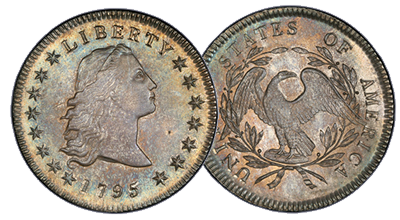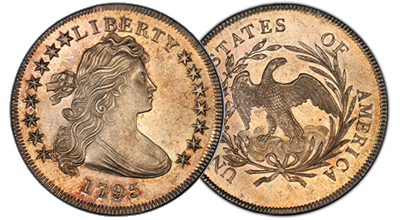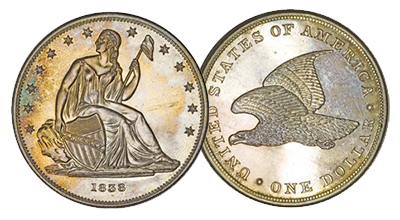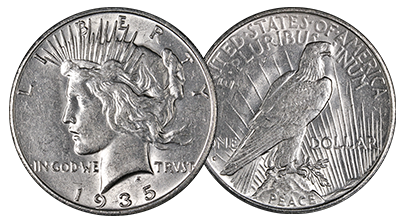Silver Dollars For Sale
The United States Dollar is a coin worth 100 cents. In 1792, as per the 1792 Coinage act, the US Dollar was instated as the standard unit of money for the country.
The original US Dollar contained almost 90% silver, but now the coin is 75% copper and 25% nickel, with no silver remaining in its composition. The reason for this was the Mint's move to copper-nickel coinage in 1965.
Bullion Sharks offers Flowing Hair Dollars, Draped Bust Dollars, Gobrecht Dollars, Seated Liberty Dollars, Trade Dollars, Morgan Silver Dollars, and Peace Dollars.
Flowing Hair Dollar
The Flowing Hair Dollar was the first type of dollar minted in the United States in 1794. The coin was composed of 89.25% silver and 10.75% copper.
Robert Scot was the designer of the bust of liberty and eagle that appeared respectively on the obverse and reverse sides of the coin. This coin was struck between 1794 and 1795 at the Philidelphia mint.
Mintages for the Flowing Hair Dollar were 1,758 in its first year and 160,295 in its final year.
Draped Bust Dollar
The Draped Bust Dollar replaced the Flowing Hair Dollar in 1795. The Draped Bust Dollar originally ran from 1795 until 1804. However, in 1834, an additional set was struck. Although, these later dollars were dated 1804. It's unknown why an earlier date was used, but 1804 Draped Bust coins are very desirable to collectors for this reason.
The official designer of this dollar is unknown. However, Gilbert Stuart is widely accepted as its creator. The obverse of the Draped Bust Dollar features the bust of Liberty, while the reverse side depicts a heraldic eagle.
The lowest mintage of the Draped Bust Dollar was 7,776 and the highest 423,515.
Gobrecht Dollar
In 1836, the Gobrecht Dollar succeeded the Draped Bust. The coin gained its name from its designer, Christian Gobrecht. The Gobrecht Dollar ran until 1839 and featured a seated Lady Liberty on its obverse side with a soaring bald eagle on the reverse.
In 1838, the design of the coin was changed. On the obverse side, 13 stars were added to surround Liberty, and the same number were removed from the reverse side.
The exact mintage records of the Gobrecht Dollar are unknown. However, it is estimated that 1,000 were struck during 1836 and just 300 in 1839.
Seated Liberty Dollar
The Seated Liberty Dollar had a comparatively long run and was produced between 1840 and 1873. Designed by Christian Gobrecht, the coin features the same seated Liberty as depicted on the 1838 Gobrecht Dollar. Although, the reverse side was changed to show a left-facing bald eagle.
The lowest mintage of the Seated Liberty Dollar occurred in 1852 when 1,100 coins were struck. The highest year was 1872 with 1,105,500 coins produced.
Trade Dollar
The Trade Dollar was introduced in 1873 to compete with silver trade coins popular in East Asia. This coin was regularly struck until 1878, but striking of proof coins continued in limited quantities until 1885.
William Barber designed both sides of the Trade Dollar. The obverse side featured a seated Lady Liberty facing left, and the reverse side an eagle with three arrows in its left claw and an olive branch in it's right.
The lowest mintage of the Trade Dollar occurred in 1885 as only five examples have been found. The highest mintage year occurred in 1877 when over nine million were struck.
Morgan Silver Dollar
The Morgan Silver Dollar was struck between 1878 and 1904, and again for a singular year in 1921. The coin was named after its designer, George T. Morgan, who created the Liberty bust an eagle clutching arrows and an olive branch on the respective obverse and reverse sides of the coin.
The Morgan Silver Dollar's production was stopped in 1904 after the silver reserves under the Sherman Silver Purchase Act were depleted. Then, in 1918, the Pittman act authorized melting and recoining silver dollars. So, the Morgan Silver Dollar was struck for a final year in 1921.
1921 saw the highest mintage year for the Morgan Silver Dollar as 44,690,000 coins were produced.
Peace Dollar
Designed by Anthony de Francisci, the Peace Dollar ran between 1921 and 1928, and from 1934 to 1935. The coin was a result of a competition to design an emblem of peace that commemorated the first world war.
The obverse of the Peace Dollar shows Lady Liberty wearing a radiate crown with the motto "In God, We Trust." The reverse of the coin shows an at rest eagle holding an olive branch.
The Peace Dollar mintages ranged from 360,649 to more than 50 million.
Learn more about: franklin half dollar, morgan silver dollars, war nickels, 2025 silver eagle, biblical coins.










